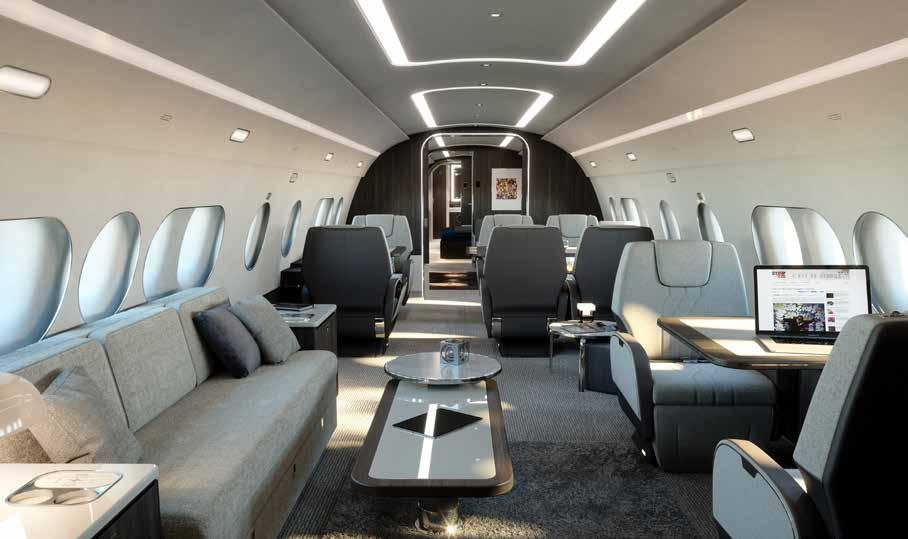













Based on the over 100-seat twin-engine jetliner, now optimised for the corporate market in a version providing seating for up to nineteen passengers. The ACJ Two-Twenty needs a runway just 1,600 metres long and can fly for over twelve hours without stopping. The interiors offer breath-taking style and tempting opportunities for personalisation
 by Sergio Barlocchetti - ph.
by Sergio Barlocchetti - ph.
Take an aircraft designed for regional transport with a payload of over one hundred passengers like the Airbus A-220 – originally the Bombardier CSeries – then task a team of engineers with transforming it into a business jet. The result is the Airbus ACJ Two-Twenty. The aircraft now features significant innovations and developments, so it is not simply a spinoff of its A220-100 predecessor – it has been deliberately created expressly fort business aviation, aiming to provide outstanding comfort in a cabin certified for 19 passengers, with six VIP areas in a space of 73 square metres.

One of the modifications setting it apart from the commercial version is a new, more powerful pressurisation system. At a typical cruising height of 41,000 feet this provides a cabin pressure equivalent to below 5,900 ft compared to over 6,500 ft in the airliner version. For even greater passenger comfort, the ACJ Two-Twenty can be equipped with a humidification system that takes relative humidity levels to over twenty per cent, resulting in a more pleasant interior environment. Lovers of fine food will be pleased to find that, unlike passengers on commercial flights, they will be able to enjoy aromas and flavours as intensely as they would on the ground. Airbus has also fitted out the aircraft with all the features present on a large jet like the A-350, with electro-chromatic windows and improved soundproofing, especially in the rest areas, with sound levels of less than 50dB at cruising speed. Of course, great attention has been
paid to connectivity – Ku band satellite connectivity is standard, although other systems based on different satellite systems will soon be available. The aircraft interiors are extremely spacious – the fuselage provides a usable space that is 23.8 metres long, 3.3 metres wide and 2.1 metres high, so the vast majority of passengers will be able to stand upright comfortably. The total interior area is 73 square metres. Operationally speaking, the standard features of the ACJ TwoTwenty version include a highest max take-off weight (MTOW) of 63.7 tonnes with the ability to operate within ETOPS 180 parameters (Extended Range Twin-engine Operation Standards), the aeronautical rules applying to long-range flights carried out by twin-engine aircraft above regions with only a small number of airfields suitable for emergency landings, like oceans or deserts. This means greater versatility and mission performance capability. Another important factor for business jets in this category is performance – while the original commercial model was powered by two 19 klb PW1519G engines, the ACJ TwoTwenty boasts a pair of 21 klb Pratt&Whitney PW1521G turbofan units. Airbus is maintaining its edge over competing models by researching the use of even more powerful engines like the 24 klb PW1524G. Of course, fuel carrying capability has been modified to provide the required range – the basic A220 airliner carries 21,805l of fuel, while the ACJ TwoTwenty is equipped with either four (as baseline) or five (if requested) additional fuel tanks to achieve that extra range of

 Above: the new design interior divided into flexible spaces. Note the low-consumption lighting sys-tem in the cabin roof. Left, the sleeping section with bed in front of a row of five windows. Opening, the central fuselage section divided into a dual club-working space and lounge. Below, the aircraft at take-off
Above: the new design interior divided into flexible spaces. Note the low-consumption lighting sys-tem in the cabin roof. Left, the sleeping section with bed in front of a row of five windows. Opening, the central fuselage section divided into a dual club-working space and lounge. Below, the aircraft at take-off
up to 5,650 nm, or over twelve hours. Like many other bizjets, in order to avoid having to rely on handling companies and to enable operations in remote, less well-equipped airfields, the ACJ Two-Twenty fits integrated airstairs located on the right-hand side of Door 1.

Maintenance costs are always a headache for operators, especially during down times as these become indirect costs to be added to those incurred by flight hours. This has led the company to develop a Low Utilization Program tailored for business aviation, moving from hours (airliner) to calendar based (corporate jet) tasks to improve availability and reduce costs without impacting safety.
As regards performance, the main difference between the ACJ220 and the A220-100 is range – thanks to additional fuel tanks the ACJ Two-Twenty can travel for up to 5,650 nm or 12 hours of non-stop flight, well above
the 3,450 nm range of the A220-100. In terms of distances, this means the aircraft can fly from London to Los Angeles or Tokyo without stopovers at a maximum operational speed of Mach 0.82, with the opportunity to reduce fuel burn by almost 25%. The minimum recommended runway length at maximum take-off weight is 5,470ft (1,670m), much shorter than for lighter ultra-long-range competitors.
The price? At the moment it’s impossible to find out, but the starting figure is not too distant from that of all the other corporate jets with ultra-longrange capabilities. To this can be added the price of any whim desired by the purchaser, including interior furnishings by one of the company’s favoured artists, guaranteed to make passengers’ jaws drop. What’s sure is that the psychological barrier of a hundred million dollars is bound to be reached. www.acj.airbus.com